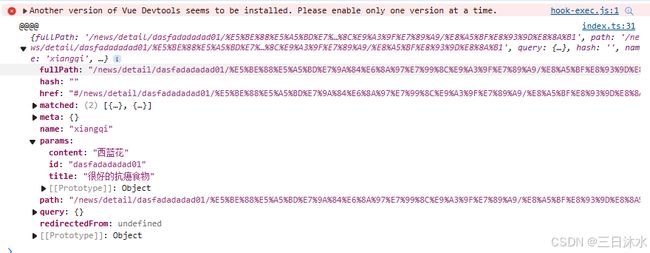VUE之路由Props、replace、编程式路由导航、重定向
目录
1、路由_props的配置
2、路由_replaces属性
3、编程式路由导航
4、路由重定向
1、路由_props的配置
1)第一种写法,将路由收到的所有params参数作为props传给路由组件
只能适用于params参数
// 创建一个路由器,并暴露出去
// 第一步:引入createRouter
import {createRouter,createWebHistory,createWebHashHistory} from 'vue-router'
// 引入一个个可能呈现组件
import Home from '@/pages/Home.vue'
import News from '@/pages/News.vue'
import About from '@/pages/About.vue'
import Detail from '@/pages/Detail.vue'
// 第二步:创建路由器
const router = createRouter({
history:createWebHashHistory(), //路由器的工作模式
routes:[ //一个个路由规则
{
path:'/home',
component: Home
},
{
path:'/news',
component: News,
children:[
{
name: 'xiangqi',
path:'detail/:id/:title/:content?', //用于params参数占位,加?号可传可不传
// path:'detail',
component:Detail,
//第一种写法:将路由收到的所有params参数作为props传给路由组件
props: true
]
},
{
path:'/about',
component: About
},
]
})
export default routercomponent:Detail,
//第一种写法:将路由收到的所有params参数作为props传给路由组件
props: true相当于:
- 编号:{
{id}}
- 编号:{
{title}}
- 编号:{
{content}}
-
{
{news.title}}
2)第二种写法,函数写法,可以自己决定将什么作为props给路由组件
适用于query参数类型的传递
{
path:'/news',
component: News,
children:[
{
name: 'xiangqi',
path:'detail/:id/:title/:content?', //用于params参数占位,加?号可传可不传
// path:'detail',
component:Detail,
//第二种写法:可以自己决定将什么作为props给路由组件
props(route){
console.log('@@@@',route)
return route.params
}
}
]
}其中:console.log打印的route参数结构如下:
3)第三种写法,对象写法,只能写死,不适用
{
path:'/news',
component: News,
children:[
{
name: 'xiangqi',
path:'detail/:id/:title/:content?', //用于params参数占位,加?号可传可不传
// path:'detail',
component:Detail,
props:{
a: 100,
b: 200,
c: 300
}
}
]
},2、路由_replaces属性
1)作用:控制路由跳转时操作浏览器历史记录的模式。
2)浏览器的历史记录有两种写入方式:分别为push和replace:
- push 是追加历史记录(默认值)
- replace是替换当前记录
3)开启replace模式:
News
3、编程式路由导航
脱离
-
{
{news.title}}
编程式路由导航应用场景:
1、满足某些条件才跳转
2、鼠标划过就跳转
4、路由重定向
const router = createRouter({
history:createWebHashHistory(), //路由器的工作模式
routes:[ //一个个路由规则
{
path:'/home',
component: Home
},
{
path:'/about',
component: About
},
{
path: '/',
redirect: '/home'
}
]
})
export default router